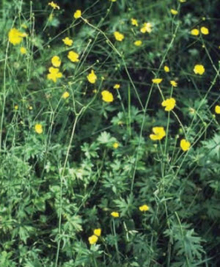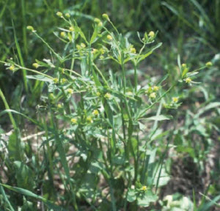Quick facts
-
Fresh tall and smallflower buttercup in pastures are toxic to horses.
-
Horses that eat these species may develop:
-
Blisters on the mouth, gut and skin
-
Diarrhea or colic
-
Swelling of the face, nose, lips and skin
-
-
Pasture management and herbicides can help control tall and smallflower buttercup in pastures.
-
These buttercup species prefer to grow in lowland meadows, pastures and fields.
Identifying
Stems
-
Slender
-
Slightly hairy
-
Branched
-
Heights range from 6 inches to 3 feet
Leaves
-
Lower leaves of smallflower buttercup are kidney-shaped.
-
Lower leaves of tall buttercup are deeply divided and hairy.
-
Upper leaves are smaller and differ in shape.
Flowers
-
Small and yellow
-
Divided into five to seven petals
Lifecycle
-
Tall buttercup is a perennial.
-
Smallflower buttercup can be an annual or biennial.
Where is it found?
Tall and smallflower buttercup grow throughout most of the U.S., but rarely grows in western Minnesota, the Dakotas, or eastern Montana.
They prefer to grow in lowland meadows, pastures and fields. Tall buttercup prefers moist soil conditions.
Toxicity
Tall and smallflower buttercup are toxic to horses when eaten fresh in pasture. Toxicity tends to be higher while the plants are flowering. The dried plant isn’t normally toxic.
-
Blistering of the mouth, skin and gut
-
Swelling of the nose, lips, face and skin after contact
-
Diarrhea and colic after eating
-
Tremors, seizures and paralysis rarely occur
Remove the horses from pastures with buttercup species. Supportive care for colic and diarrhea may include fluid therapy and a pain killer.
Control
-
Properly manage pastures. Don’t allow your horses to overgraze pastures.
-
Improving drainage can help control this weed.
-
Multiple herbicide applications may help.
-
Follow all directions and grazing restrictions listed on the herbicide label.
-
Read and follow all pertinent information.
-
Reviewed in 2021



